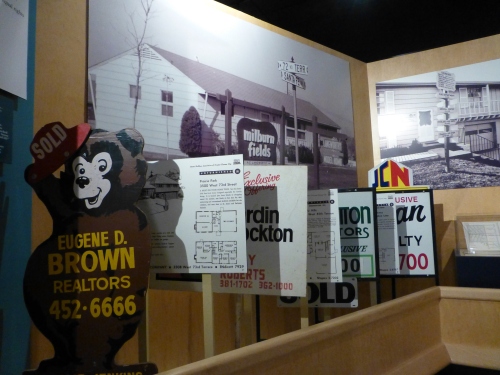Despite growing up in Kansas City, Kansas, my husband and I have discovered just how little we know about the history of the Kansas side of the Kansas City Metro area. Our quest: to visit as many of the museum and historic sites as we can. We recently toured the Johnson County Museum, which includes a completely restored model house built by the Kansas Power and Light company in 1954. The all-electric house was designed to showcase the wonders of modern suburban living. The Prairie Village house was showcased in newspapers and magazines like Better Homes & Gardens and was toured by 62,000 people in the year that it was open to the public.
Four different families lived in the house before it was donated to the Johnson County Museum. It’s both nostalgic in a Rob-and-Laura-Petrie sort of way while also featuring some technology that’s pretty spiffy even today.

The 1950s American Dream: a ranch house in the ‘burbs.
Unlike houses of previous generations, the kitchen of the future is by the front door. The lady of the house, who should be nothing if not efficient, can now watch her children play in the front yard, answer the doorbell, easily access the washer/dryer and mangle iron, and keep dinner on schedule!

That recreated pink formica countertop is worth $80,000.
The house featured a machine that was both a washer and a dryer so that laundry could get done even on days when the weather wouldn’t allow for clothes to be line-dried. The problem: no spin cycle. It took a long time to wash and dry a single load. But that’s okay, because electricity is cheap in the 1950s!

It’s a washer AND a dryer.
Heating up an iron is inefficient. Enter this monster machine, which is supposed to let you roll your clothes through to iron them against the heating element. It was far better at burning hands and catching fingers. Also, it takes a lot more space than an iron.

This is supposed to iron your clothes, but mostly, it mangles your hands.
The bathroom of the future features a three-bulb light fixture. The white bulb emits regular light, the red bulb is supposed to sanitize the bathroom, and the amber light is a tanning light.

A bathroom light that lights, tans, and sanitizes. Sort of.
The modern living room includes a spiffy hiding place for your 19-inch black-and-white television: with the push of a button, the artwork slides away to reveal the screen. Remotes weren’t invented yet, though, so you still had to get up to change the channel.

The living room of the future: a television is hidden by a painting that will slide away with the touch of a button. Who needs a real fireplace when you can have an electric one?
Beyond the All-Electric House, the rest of the Johnson County Museum does a great job telling the story of the growth of Johnson County, an area that was primarily developed in the post-World War II years as a suburb of Kansas City, Missouri. I find this fascinating because it’s one of the few places in Kansas that doesn’t feel, well, Kansasy, and now I understand why. The museum also does a great job of explaining in an honest and factual way the fact that much of the county’s development through the mid-20th Century was seriously segregated, with land developments prohibiting sales to minorities and certain religious backgrounds. In addition, many historic structures and farms were leveled to make way for suburban living.

Most KCK kids lost friends when their friends’ families moved to Johnson County.
This museum is also one of the most kid-friendly county museums I’ve seen. Every room includes play areas that reflect the interpretive educational goals of the room, and a large Kidscape is full of kid-sized places to explore.

The Johnson County Museum Kidscape area.
If you’re in the Johnson County area, this museum is worth a stop. The main museum exhibits are free, with a $2 per person fee to tour the electric house.






















